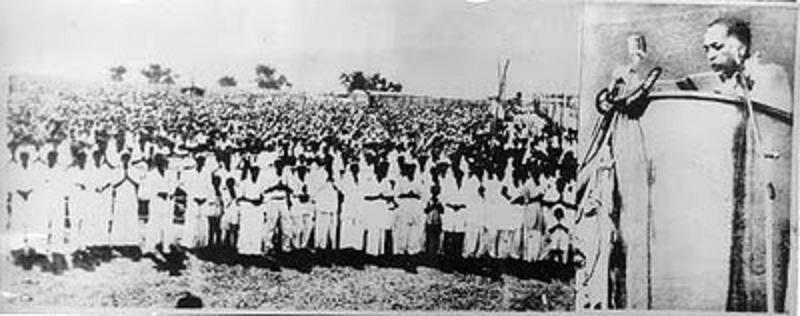Ratnesh Katulkar
The Tipitaka is believed to be a collection of teachings preached by the Buddha and some of his main disciples. It is therefore considered to be the complete knowledge and philosophy of the Buddha. However, most people are unaware that, apart from the teachings preserved in the Tipitaka, the Buddha has also shared many important things that could not be included in it and got lost with time!
The question is: what were those teachings that got lost, and why could they not find a place in the Tipitaka? The answer is those teachings that were preached by the Buddha on those occasions when there was no order of Bhikkhus present to memorize them and keep records. In such a situation, these teachings remained limited only between the Buddha and the person to whom he was addressing. Especially when the person was a common man, these teachings were bound to get lost. How could an ordinary man get these precious words included in the Tipiṭaka? After all, the Tipitaka is only a collection of those words of the Buddha that he spoke on those occasions where the Bhikkhu Sangha was present. These Bhikkhus used to remember those teachings very well and tell them to other Bhikkhus. Later, a special class among Bhikkhus called Bhanaka emerged who were experts in the art of memorization, and they kept records of them through their various methods and passed them on from generation to generation until all these words were written down in the Tipitaka. It is imperative to acknowledge that the composition of the Tipitaka in its written form did not occur in a specific period; rather, its editing and compilation took place over three centuries, from the 1st century AD to the 3rd century AD in Sri Lanka. It is inevitable that over such an extended period of over three hundred years, many new things were added to the original form of the Tipitaka while some old things were removed. This is mainly because without written material, it is impossible to remember everything as it is, and it is natural for new things to be added and untimely things to be removed as per the needs of the people with time.
Here, the question that we are dealing with is not what was removed from the Tipitaka. Rather, we are discussing the fact that some conversations during the Buddha’s lifetime could not be included in it over time! The question is, what were those things that could not be recorded? And why? We get a hint for this from some episodes of Buddha’s life. The clue starts with Siddhartha’s attainment of Buddhahood. There is a clear mention in the Vinaya Pitaka that after attaining enlightenment when the Buddha was full of happiness and enthusiasm in Uruvela, i.e., Bodhgaya, two nomadic merchants, Tapasu and Bhallika, from Utkal province, visited him. This description is presented in an exaggerated form that these merchants were ordered by the gods of their caste and community to go to Lord Buddha sitting under the Rajayatan tree and donate the laddus and buttermilk that they gave to him.
If we remove imaginary things like the order of the gods from this long metaphorical description, then it is clear that these two merchants were impressed by the Buddha and donated the food available to them. After accepting this offering, the Buddha gave them a sermon, which delighted them so much that they immediately took refuge in the Buddha and his Dhamma. Since the Sangha was not established at that time, they began to call the first followers of Dwi-Vachika, i.e., two gems, i.e., ‘Buddha’ and ‘Dhamma’. Later, when Buddha initiated the Sangha at Sarnath with his five old companions, the Sangha was formed, and since then, all the worshippers and Bhikkhus have been chanting Tisarana, i.e., Buddham Saranam Gachhami, Dhammam Saranam Gachhami, and Sangham Saranam Gachhami. However, it is noteworthy that this sermon cannot be found in the Tipitaka or might have been lost over time. Here the question arises: what did the Buddha say to these two merchants that, without any hesitation, they left their traditional religion and became lifelong worshippers of the Buddha and his Dhamma? We regret that we do not have any information on this subject. The disappearance of such an important dialogue is just one example of the many teachings and conversations that may have been lost over time.
It is more of an example of how, on many such occasions, the Buddha’s teachings and conversations with an individual or group were lost because no other Bhikkhus were present to record them.
According to the Tipitaka, Ananda, Buddha’s long-serving assistant, was instrumental in the creation of the Sutta Pitaka. He had a very sharp memory and was able to present accurate information about every moment of the Buddha’s life that had gone before him. As the Buddha’s personal assistant, he witnessed most of the Buddha’s life events alongside the Lord himself. However, it is worth noting that the bhikkhu who had previously served as Buddha’s assistant However, it is worth noting that the bhikkhu who served as Buddha’s assistant prior to Ananda lacked Ananda’s acumen. As a result, all events and conversations that may have occurred in front of hid were not recorded and are therefore unavailable to us.
Also, there must have been many occasions when Buddha had thoughts but could not express them to anyone because no one would have asked him questions about them. As a result, these thoughts remained in the Buddha’s mind and did not reach us. After all, how can we forget that the majority of the teachings in the Tipitaka were only included because someone or some group asked the Buddha their queries or questions? There is no birth of an answer in the absence of any question or query from others. In such cases, the Buddha’s teachings and philosophy remained with him. As a result, we should not have the slightest doubt that only a part of the Buddha’s complete knowledge has been included in the Tipitaka.
In this regard, an incident from the last days of Buddha is noteworthy. He once went to a forest with Ananda and said to him, “Ananda, please pick some leaves from this forest.” Hearing this, Ananda immediately brought some leaves and presented them to the Buddha. The Buddha looked at these leaves and asked, “Ananda, are there only this many leaves in this forest?” “No, there are infinite leaves in this forest,” Ananda responded, “what I have brought is only a very small quantity of the fallen leaves.” Then Buddha said, “In the same way, Ananda, whatever teachings I have given in my life are only a small part of the immense knowledge, knowledge is infinite, there is no limit to it.”
From the above analysis and the Buddha’s statement, it becomes clear that we should never make the mistake of considering the Tipitaka as the ultimate and complete truth. Rather, we should continue to make every possible effort to increase human knowledge. However, it should not be interpreted that only incomplete Dhamma has come down to us. Whatever teachings of the Buddha we have got through the Tipitaka are complete in principle. The Dhamma is based on three basic elements: Sheel, Samadhi, and Pragya, i.e., in a modern context, these three words are rightly translated as liberty, equality, and fraternity by Dr. Ambedkar. There should not be the slightest doubt that one who has understood Sheel, Samadhi, and Pragya has understood the entire Dhamma.
At the same time, when one reads the suttas (sutras Skt.) of the Tipitaka, one should be aware that what is written in them is not a complete and verbatim description of the said subject but is just a sutra or formula. Just as every formula in the field of education shows the way to solve a particular problem in very few words but could be decoded only by specialists, if a scientific community gets hold of any special formula, they can make great discoveries or inventions using it, but this formula remains meaningless to an ordinary person. Similar to the suttas (sutras) of the Tipitaka, they are not an exhaustive and word-for-word description of the subject matter. Rather, they are more like formulas that guide how to approach a particular problem, conflict, or situation. Just like a scientist can achieve great discoveries using a specific formula, the suttas (sutras), if decoded well, can serve as a guide for individuals seeking to deepen their understanding of the Dhamma.
For instance, the formula E=MC2 discovered by Einstein may have profound implications and significance, but for an average person, it may hold no more meaning than the simple ABCD taught in kindergarten. Without the appropriate knowledge and understanding of physics, the formula may seem irrelevant or insignificant to individuals who lack the necessary context to comprehend its significance. It is therefore crucial to understand that reading the suttas (sutras) alone will not provide a comprehensive understanding of the entire Dhamma until they are well understood. Similarly, it is essential to study the suttas (sutras) in conjunction with other resources and to approach them with an open mind and willingness to learn. It is important to note that, as discussed above, the suttas compiled in the Tipitaka are not verbatim compilations of Buddha’s words but are preserved discourses or formulas, which is why they are referred to as sutras or suttas rather than teachings. The correct and exact translation of a sutta in English is formula. Take, for instance, the Dhammachakka Pavattan Sutta, which is present in two Pitakas in its original Pali form. One version can be found in Chapter 56 of the Samyukta Nikaya, while the other can be found in Part 1 of the Mahavagga of the Vinaya Pitaka. Despite being a great sermon, the sutra is limited to just 4 pages when read in both places. It is important to understand that simply reading the sutras compiled in the Tipitaka will not provide complete knowledge of the Dhamma. Reading them literally without contemplation and practice will not lead to a correct understanding of their meaning.
The Sutta Pitaka, in particular, contains all philosophical teachings in the form of suttas, which require careful contemplation to fully grasp their significance. Therefore, it is crucial to approach these teachings with a serious and contemplative mindset to reach the truth.
It is interesting to note that some Mahayanists, Theravadins, and other sectarians give more importance to other suttas than to the Dhammachakka Pavattana Sutta, which is surprising considering that it was from this sermon that the wheel of Buddhism turned for the first time. The propagation of Dhamma started among both the elite and the common people. After hearing this sermon, Gautama’s five former fellow monks expressed their desire to join the Sangha, leading to the establishment of the Sangha. Despite the significance of this first preserved sermon, it is presented only in four pages. This raises questions about its completeness. Did the five ascetics who listened to the sermon abandon their traditional beliefs and become followers of the Buddha without any doubts or questions after hearing just a four-page-long sermon?
It is important to note that the Buddha’s sutras are not literal translations of his sermons, but rather an essence or formula of his teachings. Therefore, it is crucial not to make the mistake of interpreting any sutra of Buddha by its literal translation. In such a situation, for those who want to study the Buddha’s religion in depth, it will be necessary for them not to make the mistake of considering the information available in Tipitaka as the final Buddha’s words, but to elaborate and contextualize it to understand its true meaning.
This article is a translation of an excerpt from my Hindi book ‘Buddha ka Pratham Updesh: Dhammachakka Pavattan Sutta Ki Aadhunik Vyakhya’. This book is available on https://www.amazon.in/%E0%A4%AC%E0%A5%81%E0%A4%A6%E0%A5%8D%E0%A4%A7-%E0%A4%AA%E0%A5%8D%E0%A4%B0%E0%A4%A5%E0%A4%AE-%E0%A4%89%E0%A4%AA%E0%A4%A6%E0%A5%87%E0%A4%B6-%E0%A4%A7%E0%A4%AE%E0%A5%8D%E0%A4%AE%E0%A4%9A%E0%A4%95%E0%A5%8D%E0%A4%95%E0%A4%AA%E0%A4%B5%E0%A4%A4%E0%A5%8D%E0%A4%A4%E0%A4%A8-%E0%A4%B5%E0%A5%8D%E0%A4%AF%E0%A4%B5%E0%A4%B9%E0%A4%BE%E0%A4%B0%E0%A4%BF%E0%A4%95-ebook/dp/B0CG4LH5YZ/ref=sr_1_2?crid=ABAGYMDZ6OHZ&keywords=ratnesh+katulkar&qid=1700148050&sprefix=ratnesh+k%2Caps%2C361&sr=8-2
~~~
Ratnesh Katulkar is an independent researcher. His recent published book is ‘Outcasts on the Margins: Exclusion and Discrimination of Scavenging Communities in Education’.










